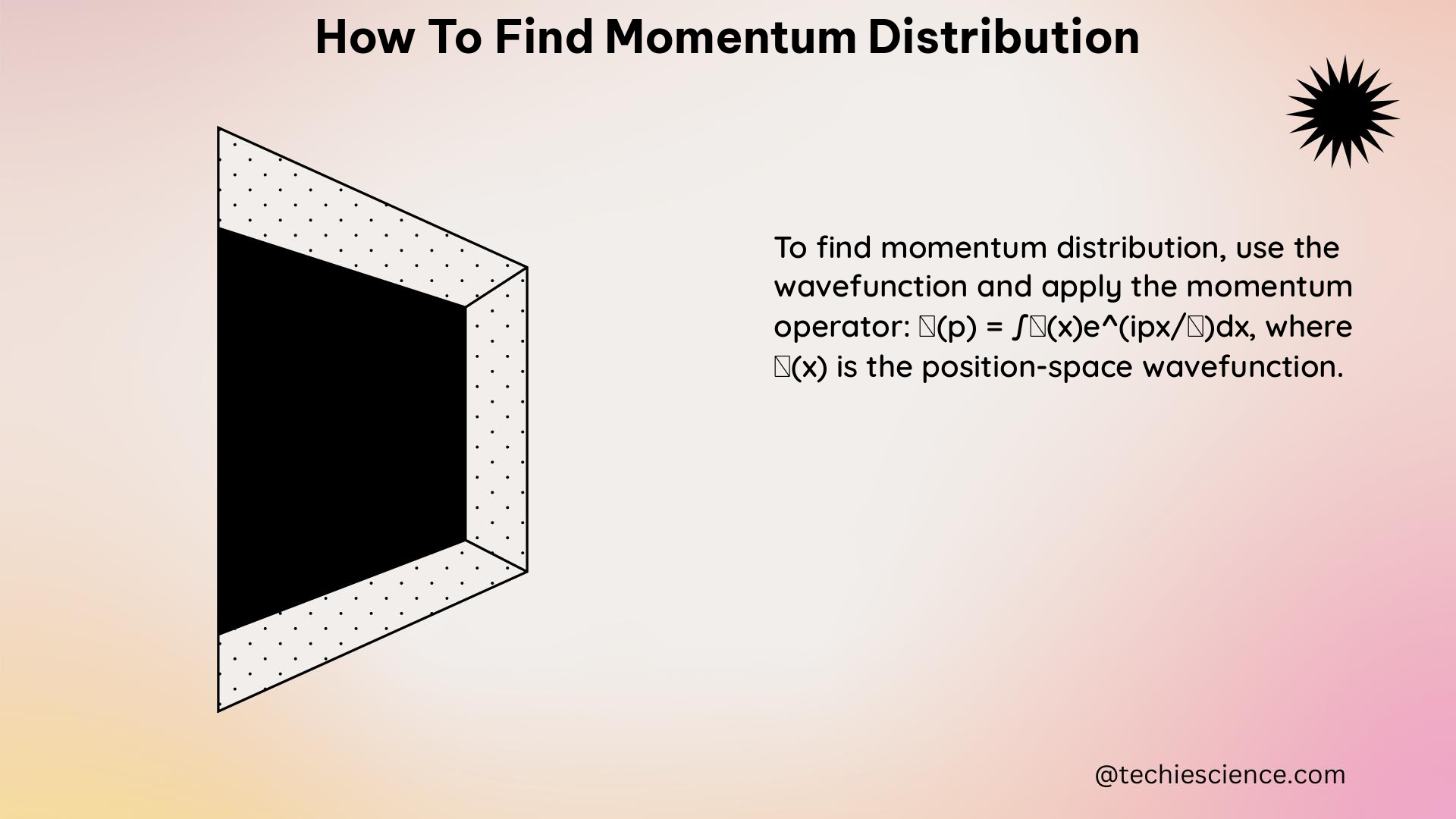The momentum distribution of a quantum mechanical system is a crucial concept in understanding the behavior of particles at the microscopic level. It represents the probability density of finding a particle with a particular momentum, and is directly related to the wavefunction of the system. To find the momentum distribution, we need to follow a specific set of steps and utilize various formulas and techniques. This comprehensive guide will walk you through the process in detail, providing you with the necessary tools and knowledge to master this fundamental aspect of quantum mechanics.
Understanding the Momentum Distribution
The momentum distribution, denoted as ρ(p), is given by the square of the magnitude of the Fourier transform of the wavefunction Ψ(x) in position space. This relationship is expressed by the formula:
ρ(p) = |φ(p)|^2
where φ(p) is the Fourier transform of the wavefunction, defined as:
φ(p) = (1/√(2πℏ)) ∫ Ψ(x) e^(-ipx/ℏ) dx
The momentum distribution provides a complete description of the momentum state of the particle, just as the wavefunction in position space describes the spatial distribution of the particle.
Steps to Find the Momentum Distribution

To find the momentum distribution of a quantum mechanical system, follow these steps:
-
Determine the Wavefunction: Start by finding the wavefunction
Ψ(x)of the system in position space. This wavefunction will depend on the specific problem and the boundary conditions of the system. -
Calculate the Fourier Transform: Using the formula for the Fourier transform, compute
φ(p)by integrating the product of the wavefunctionΨ(x)and the complex exponential terme^(-ipx/ℏ)over the entire position space. -
Obtain the Momentum Distribution: Square the magnitude of the Fourier transform
φ(p)to get the momentum distributionρ(p). This step is crucial, as the momentum distribution represents the probability density of finding the particle with a particular momentum.
Examples and Applications
Let’s consider a few examples to illustrate the process of finding the momentum distribution.
Example 1: Particle in a Box
For a particle confined in a one-dimensional box of length L, the wavefunction is given by:
Ψ(x) = √(2/L) sin(nπx/L)
where n is the energy level of the particle.
The Fourier transform of this wavefunction is:
φ(p) = √(L/(2πℏ)) ((-i)^n/√2) [(e^(ipL/(nℏ)) - 1)/(pL/(nℏ) - nπ) - (e^(-ipL/(nℏ)) - 1)/(pL/(nℏ) + nπ)]
Squaring the magnitude of φ(p) gives the momentum distribution:
ρ(p) = (L/(2πℏ)) (1/2) [sin^2(pL/(2nℏ))/(pL/(2nℏ))^2 + sin^2(pL/(2nℏ))/(pL/(2nℏ))^2 - sin(pL/(nℏ))/(pL/(nℏ)) cos(pL/(nℏ))]
This momentum distribution depends on the length of the box L and the energy level n of the particle.
Example 2: Harmonic Oscillator
For a particle in a one-dimensional harmonic oscillator potential, the wavefunction is given by the Hermite functions:
Ψ(x) = (1/√(2^n n! √π)) H_n(x/√(ℏ/mω)) e^(-x^2/(2ℏ/mω))
where H_n(x) is the Hermite polynomial of order n, m is the mass of the particle, and ω is the angular frequency of the oscillator.
The Fourier transform of this wavefunction is more complex, involving the Hermite functions and the Gaussian function. The resulting momentum distribution ρ(p) will depend on the energy level n and the parameters of the harmonic oscillator potential.
Numerical Examples and Visualizations
To further illustrate the concept, you can provide numerical examples with specific values for the system parameters and plot the resulting momentum distributions. This can help students visualize the shape and characteristics of the momentum distribution for different quantum mechanical systems.
Advanced Techniques and Considerations
For more complex systems or specific applications, there are advanced techniques and considerations that can be employed to find the momentum distribution:
-
Quantum Mechanical Operators: The momentum operator in quantum mechanics is related to the differential operator in position space. Understanding the properties and commutation relations of these operators can provide deeper insights into the momentum distribution.
-
Uncertainty Principle: The Heisenberg uncertainty principle, which relates the position and momentum of a particle, has important implications for the momentum distribution and its interpretation.
-
Many-Body Systems: For systems with multiple particles, the momentum distribution can be generalized to include the correlations and interactions between the particles, leading to more complex expressions and considerations.
-
Experimental Techniques: In practice, the momentum distribution can be measured using experimental techniques such as electron momentum spectroscopy or neutron scattering. Understanding the experimental methods and their limitations can provide valuable context.
-
Computational Approaches: Numerical simulations and computational methods can be employed to calculate the momentum distribution for more complex systems or to explore the effects of various parameters on the distribution.
Conclusion
Finding the momentum distribution of a quantum mechanical system is a fundamental skill in understanding the behavior of particles at the microscopic level. By following the steps outlined in this comprehensive guide, you can master the techniques and formulas necessary to determine the momentum distribution for a variety of quantum systems. Remember to practice with different examples, explore advanced concepts, and stay up-to-date with the latest developments in this fascinating field of quantum mechanics.
References
- Griffiths, D. J. (2005). Introduction to Quantum Mechanics (2nd ed.). Pearson Prentice Hall.
- Shankar, R. (1994). Principles of Quantum Mechanics (2nd ed.). Plenum Press.
- Sakurai, J. J., & Napolitano, J. J. (2017). Modern Quantum Mechanics (2nd ed.). Cambridge University Press.
- Cohen-Tannoudji, C., Diu, B., & Laloë, F. (2019). Quantum Mechanics (2nd ed.). Wiley-VCH.
- Merzbacher, E. (1998). Quantum Mechanics (3rd ed.). Wiley.

The lambdageeks.com Core SME Team is a group of experienced subject matter experts from diverse scientific and technical fields including Physics, Chemistry, Technology,Electronics & Electrical Engineering, Automotive, Mechanical Engineering. Our team collaborates to create high-quality, well-researched articles on a wide range of science and technology topics for the lambdageeks.com website.
All Our Senior SME are having more than 7 Years of experience in the respective fields . They are either Working Industry Professionals or assocaited With different Universities. Refer Our Authors Page to get to know About our Core SMEs.